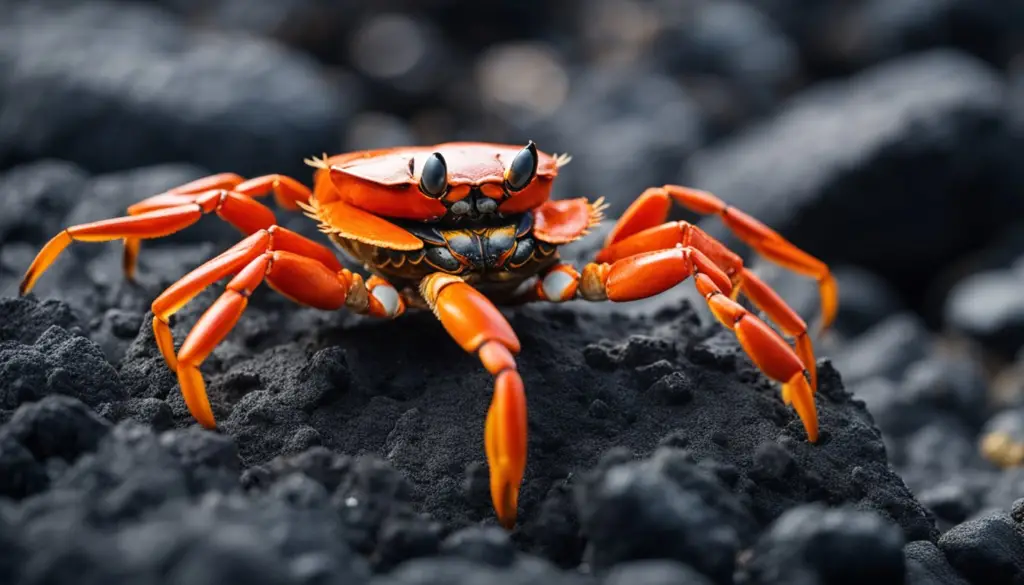The Galapagos Sally Lightfoot Crab (Grapsus grapsus) is one of the most colorful and eye-catching species found on the rocky shores of the Galapagos Islands. Known for its agility and vivid hues, this crab has captivated visitors and scientists alike. Its role in the ecosystem and remarkable adaptability make it a fascinating creature. Here are seven fun facts about the Galapagos Sally Lightfoot Crab that highlight its unique features and behaviors.
1. A Rainbow of Colors
One of the most striking features of the Galapagos Sally Lightfoot Crab is its vibrant coloration. Adult crabs display a mix of bright red, orange, blue, and yellow hues, with their legs often speckled with spots. This makes them highly visible against the dark, volcanic rocks of the Galapagos shores.
Interestingly, juvenile crabs are much duller, often appearing black or dark brown. This darker coloration helps them blend into the rocks, providing camouflage from predators such as birds.
Color Evolution:
- Adults: Bright red, orange, blue, and yellow.
- Juveniles: Darker, more camouflaged for protection.
2. Named After a Dancer
The name “Sally Lightfoot” comes from the crab’s quick, agile movements, which resemble the nimble footwork of a dancer. These crabs are incredibly fast and can scuttle in all directions, including sideways and backward, allowing them to dodge waves and predators with ease. Their quick, light steps help them move across the slippery, rocky shores without losing their footing.
Their agility and speed have earned them the nickname “lightfoot,” as they appear to dance across the rocks with impressive grace and swiftness.
Agility:
- Nimble: Can move quickly in all directions.
- Namesake: Named for their quick, dancer-like movements.
3. They Play an Important Role in the Ecosystem
Sally Lightfoot Crabs are vital to the Galapagos ecosystem. They are primarily scavengers, feeding on organic material found along the shore, including dead fish, algae, and plant matter. This makes them important cleaners of the shoreline, as they help keep the environment free of waste and decay.
In addition to scavenging, they are also known to eat ticks off of marine iguanas, providing a form of natural pest control for these iconic Galapagos reptiles.
Ecological Role:
- Scavengers: Help clean up dead plant and animal material.
- Tick Removal: Eat ticks off marine iguanas, providing a cleaning service.
4. Masters of the Rocky Shoreline
The rocky shorelines of the Galapagos can be treacherous, but Sally Lightfoot Crabs are expert climbers. Their flat, broad bodies and strong legs allow them to grip onto slippery rocks, even when waves crash against them. They are often seen scuttling around tidal pools, darting in and out of crevices as they search for food.
Their ability to cling to rocks in rough conditions and avoid being swept away by waves is key to their survival. This skill also helps them escape from predators like birds, who find it difficult to catch these fast-moving crabs in such rugged terrain.
Rocky Survivors:
- Strong climbers: Adapted to clinging onto wet, slippery rocks.
- Wave dodgers: Can avoid waves and predators with ease.
5. They Molt to Grow
Like all crabs, the Sally Lightfoot Crab must molt its exoskeleton in order to grow. Molting is the process by which the crab sheds its old, hard shell and forms a new, larger one. During this time, the crab is vulnerable to predators, as its new shell takes some time to harden.
Crabs molt several times throughout their lives, with juveniles molting more frequently as they grow. This molting process is essential for the crab’s growth and development, as the exoskeleton does not expand.
Molting Process:
- Sheds exoskeleton: Molts several times to grow.
- Vulnerable: The new shell takes time to harden, leaving them exposed.
6. Social and Territorial
Although Sally Lightfoot Crabs are often seen in large groups on the rocks, they are quite territorial and will defend their feeding areas from other crabs. Males, in particular, are known to be aggressive in protecting their space, engaging in brief skirmishes with other males to assert dominance.
Despite their territorial nature, they are social creatures and often gather in the same areas. This congregation behavior is primarily due to the abundance of food in specific locations along the shoreline.
Social Behavior:
- Territorial: Males defend feeding areas.
- Congregation: Often seen in groups, especially where food is plentiful.
7. Found Beyond the Galapagos Islands
While the Galapagos Islands are the most famous location for Sally Lightfoot Crabs, they are not exclusive to this region. These crabs can also be found along the Pacific coasts of Central and South America, thriving in similar rocky, coastal habitats.
However, they are most iconic in the Galapagos, where their bright colors and active behavior make them one of the most photographed and observed species by visitors to the islands.
Geographic Range:
- Wider Distribution: Found along the Pacific coast of Central and South America.
- Iconic in Galapagos: Most commonly associated with the Galapagos Islands.
Conclusion
The Galapagos Sally Lightfoot Crab is not only a visually stunning creature but also plays an important role in the ecosystem, helping to clean up shorelines and provide pest control for other species like marine iguanas. Their quick, agile movements and colorful appearance make them a favorite among wildlife enthusiasts, especially on the rocky shores of the Galapagos Islands. Whether admired for their beauty or their ecological contributions, these crabs are truly one of nature’s fascinating wonders.
FAQ
Why are they called Sally Lightfoot Crabs?
They are called “Sally Lightfoot” due to their quick, nimble movements, which resemble the lightfooted steps of a dancer.
What do Sally Lightfoot Crabs eat?
Sally Lightfoot Crabs are primarily scavengers, feeding on dead plant and animal material, algae, and occasionally ticks off marine iguanas.
Where can I find Sally Lightfoot Crabs?
They are commonly found along the rocky shorelines of the Galapagos Islands and other parts of the Pacific coast, including Central and South America.
How do Sally Lightfoot Crabs avoid predators?
Their agility and ability to cling to rocks in rough, wave-battered environments help them escape predators, while their vibrant colors serve as a warning to some.
How do Sally Lightfoot Crabs help marine iguanas?
Sally Lightfoot Crabs are known to eat ticks and other parasites off marine iguanas, helping to keep these reptiles healthy.
Are Sally Lightfoot Crabs social creatures?
While they are often seen in groups, they are quite territorial, especially males, who defend their feeding areas from rivals.


